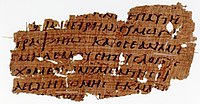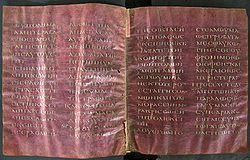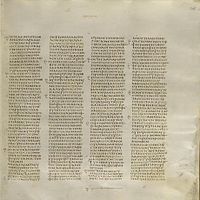Matthew 10
| Matthew 10 | |
|---|---|
 Gospel of Matthew 9:23–10:17 on Codex Sinaiticus, made about AD 330–360. | |
| Book | Gospel of Matthew |
| Category | Gospel |
| Christian Bible part | New Testament |
| Order in the Christian part | 1 |
| Gospel of Matthew |
|---|
|
Chapters |
Matthew 10 is the tenth chapter in the Gospel of Matthew in the New Testament section of the Christian Bible. Matthew 10 comes after Jesus had called some of his disciples and before the meeting with the disciples of John the Baptist. This section is also known as the Mission Discourse or the Little Commission, in contrast to the Great Commission at the end of the gospel (Matthew 28:18–20). The Little Commission is directed specifically to the "lost sheep of the house of Israel",[1] while the Great Commission is directed to all nations. The Pulpit Commentary suggests that Jesus' message in this discourse "was hardly likely to have been remembered outside Jewish Christian circles".[2]
Matthew names the twelve apostles, or "twelve disciples", in verses 1 to 4 and the remainder of the chapter consists almost entirely of sayings attributed to Jesus. In this chapter, Jesus sends out the apostles to heal and preach throughout the region and gives them careful instruction. Many of the sayings found in Matthew 10 are also found in Luke 10 and the Gospel of Thomas, which is not part of the accepted canon of the New Testament.
Text[]


The oldest known texts were written in Koine Greek. This chapter is divided into 42 verses.
Textual witnesses[]
Some early manuscripts containing the text of this chapter are:
- Papyrus 110 (3rd/4th century; extant verses 13–15, 25–27)[3][4]
- Uncial 0171 (~300; extant verses 17–23, 25–32)
- Codex Vaticanus (325–350)
- Codex Sinaiticus (330–360; complete)
- Codex Bezae (~400)
- Codex Ephraemi Rescriptus (~450; complete)
- Codex Petropolitanus Purpureus (6th century)


The twelve (10:1–15)[]
The text in verse 1 refers to "his twelve disciples" (Greek: τους δωδεκα μαθητας αυτου, tous dodeka mathetas autou). Verse 2 calls them "the twelve apostles":
²Now the names of the twelve apostles are these: The first, Simon, who is called Peter, and Andrew his brother; James the son of Zebedee, and John his brother; ³Philip, and Bartholomew; Thomas, and Matthew the publican; James the son of Alphaeus, and Lebbaeus, whose surname was Thaddaeus; ⁴Simon the Canaanite, and Judas Iscariot, who also betrayed him.
Verse 5 refers to them simply as "the twelve".
Verse 34[]
- "Think not that I am come to send peace on earth: I came not to send [or bring] peace, but a sword."[5][6]
This is a much-discussed passage, often explained in terms of the "apocalyptic-eschatological" context of the 1st century.[7]
R. T. France explains the verse, in context with the subsequent verse 35: "The sword Jesus brings is not here military conflict, but, as vv. 35–36 show, a sharp social division which even severs the closest family ties. … Jesus speaks here, as in the preceding and following verses, more of a division in men’s personal response to him."[8]
The text of Matthew's Gospel in the Book of Kells alters gladium, the Vulgate translation of makhairan "sword", to gaudium "joy", resulting in a reading of "I came not [only] to bring peace, but [also] joy".[9]
Verse 38[]
- And he who does not take his cross and follow after Me is not worthy of Me.[10]
- "Take his cross": is in the sense of "willingly to undergo the severe trials that fall to his lot" (2 Corinthians 1:5; Philippians 3:10); a figurative expression taken from the practice that "condemned criminals were compelled to take up their own cross and carry it to the place of execution" (Matthew 27:32; Luke 23:26; John 19:16)[a][11]
Parallels in the Gospel of Thomas[]
Matthew 10 contains many parallels found in the Gospel of Thomas.
- Matthew 10:16 parallels saying 39 in the Gospel of Thomas.
- Matthew 10:37 parallels sayings 55 and 101
- Matthew 10:27b parallels saying 33a.
- Matthew 10:34–36 parallels saying 16.
- Matthew 10:26 parallels saying 5b.
See also[]
- Commissioning the Twelve Apostles
- Coming Persecutions
Notes[]
- ^ Also in Artemid. ii. 56, p. 153; Plut. Mor. p. 554 A; Cic. de divin. i. 26; Valer. Max. xi. 7. apud Meyer's NT, Matthew 10:38
References[]
- ^ Matthew 10:6
- ^ Pulpit Commentary on Matthew 10, accessed 3 January 2017
- ^ Cockle, Walter E. H. The Oxyrhynchus Papyri. Volume 45. London: Egypt Exploration Society, 1999. Pages 1–3.
- ^ Comfort, P. W., & Barrett, D. P. (2001). The text of the earliest New Testament Greek manuscripts, pp. 656
- ^ Matthew 10:34 KJV
- ^ Mathewes, Charles (6 December 2010). Understanding Religious Ethics. p. 186. ISBN 9781405133517.
- ^ Cim, David (2000). "The sword motif in Matthew 10:34". Theological Studies. School of Theology, Australian Catholic University. 56 (1): 84–104. doi:10.4102/hts.v56i1.1698.
- ^ France, Tyndale New Testament Commentaries, Vol 1: Matthew (1985). 2nd ed (2008), p. 192. ISBN 978-1844742677.
- ^ Nathan, George Jean Nathan; Henry Louis Mencken (1951). The American Mercury. p. 572.
The compilers of the late seventh century manuscript, The Book of Kells, refused to adopt St. Jerome's phrase "I come not to bring peace but a sword" (" ... non pacem sed gladium"). To them the phrase made no sense and they altered it ...
- ^ Matthew 10:38 NKJV
- ^ Meyer's NT Commentary on Matthew 10. Accessed 24 April 2019.
External links[]
| Wikimedia Commons has media related to Gospel of Matthew - Chapter 10. |
- Matthew 10 King James Bible - Wikisource
- English Translation with Parallel Latin Vulgate
- Online Bible at GospelHall.org (ESV, KJV, Darby, American Standard Version, Bible in Basic English)
- Multiple bible versions at Bible Gateway (NKJV, NIV, NRSV etc.)
| Preceded by Matthew 9 |
Chapters of the New Testament Gospel of Matthew |
Succeeded by Matthew 11 |
- Matthew 10
- Gospel of Matthew chapters